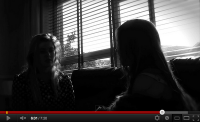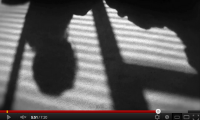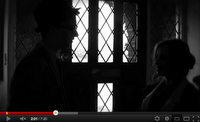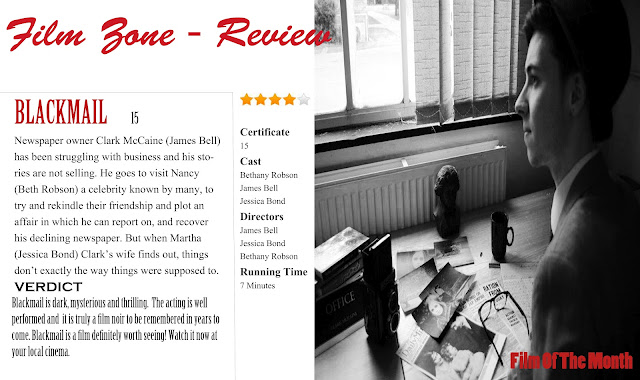Ever since the start of this new project I have learnt a lot about Film Noir, but also the conventions that come with it and how to achieve these conventions. Especially in our Film Noir, it was important to make it show that we were developing and challenging forms that would appear in either a Film or Neo Noir, that you would watch in the comfort of your own home.
The first obvious Film Noir convention that was shown in Blackmail was the fact it was in black and white, a typical feature of a Film Noir. Achieving this was fairly simple and was done during the editing process and it simply involved reducing the saturation of the film on Final Cut (Editing program which was used). We also followed the theme of having a femme fatale but challenged the typical femme fatale by leaving it open to who it actually is until the end of the film. Our group felt this would keep the original convention of a femme fatale character but also add more mystery and suspense to the overall mood of the film. Mise-En-Scene was a key element of Blackmail and we definitely had conventions of Film Noir in our own film. Especially the clothing used, smart suits, trilbys, fancy dresses etc. Also using props was a key element to make the Film successful and getting the right equipment was vital to make it appear as near to a real film noir, which was set in the 1950's.
 In most film noirs that I have watched they all feature Venetian blinds, which add that sense of gloom and suspense. Our group felt it was important to have this key convention featured in Blackmail to follow this trend that appears in so many film noirs.
In most film noirs that I have watched they all feature Venetian blinds, which add that sense of gloom and suspense. Our group felt it was important to have this key convention featured in Blackmail to follow this trend that appears in so many film noirs. 
As you can see from these two screen grabs, it shows the film noir convention that is Venetian blinds, but also the natural lighting that is used for filming can be shown in the above image. The lighting is an important convention of a film noir and is apparent and visible in the majority of well made film noirs, so for our film to be at this level we used natural lighting to our advantage during our filming process.
 Camera angles are an important convention in all film noirs, so it was important for our group to capture everything using various camera angles that would be seen in a box office film noir.
Camera angles are an important convention in all film noirs, so it was important for our group to capture everything using various camera angles that would be seen in a box office film noir.We used many different types of shots, including two shots, close ups, extreme close ups, high angle, low angle, point of view etc.
Here are two examples of different camera angles and effects which were used in our own film noir. The above image shows a two shot, but also shows off the feature of low key lighting, a convention used in film noirs to create that suspense and excitement. The other image to the left shows a low angle shot, giving off that sense of power to the person shown in the screen shot, a camera angle used a lot in a film noir.
I think Blackmail done very well at developing and challenging forms and conventions of a real film noir. We added our own touches to the film, but kept the simple and traditional conventions through out our own film.
How effective is the combination of your main product and ancillary texts?
Through out the filming and editing of our film, I had to constantly think about how my film poster and review page for Blackmail would work out. Mainly thinking about the features in the film that could be shown in the poster and review page. I thought about the dark nature of a film noir, and the mystery that comes with the eeriness and mood through out the film and put this across to the poster and review page. Looking at real products such as the film poster for 'Double Indemnity' and 'Brick' helped a lot as it showed the contrast between a typical film noir and the modern noir. I tried portraying this in my own poster and review page, especially the review page as we have the modern technology now to make things look professional.

When creating the poster I kept in mind the convention of low key lighting in our film noir, and portrayed it through the poster, as you can see in the strong shadows on the characters faces. But I brought through this theme of evil and portrayal using the colour red for the title of the film, especially using the font which appears like newspaper text, it is very key and relates to the theme of the story. When making the film review, I actually used an image taken from the film as I thought this added that touch that made you feel like you were watching the film again, and to remind you of the dark mysterious ways of a film noir. Again I brought through the colour red to create that effect of evil and portrayal.
What have you learned from your audience feedback?
When our film was finished we showed it to our class mates from other media classes and also friends of other students. We shared our opinions on each others films and what we thought was good and bad. Even though when showing our film we had a few technical problems as it was slightly jumpy here and there the overall feedback was very good and our group was pleased with the outcome, and it proved that the hard work did in fact pay off.
A few things people did mention however was the acting, saying that it could have been done more professionally and overall better executed as some parts weren't very believable.
Here is the feedback from classmates and friends. We were all very pleased with what came back, and felt that everything went well. I learnt from the feedback that people were a fan of the Venetian blinds scene and also the suspenseful nature of the film as a whole. Although we did have to make a few changes to the final scene of Blackmail because of lack of space in the office we were using, our audiences feedback on this was overall mainly positive which was a relief as our final scene was quite rushed, and could have been dealt with a lot better.
Overall I have learnt that working hard does pay off as the feedback we received was mostly all positive, and people did enjoy the overall film and conventions that were featured. What I have learnt is that we should also use our time more efficiently as towards the final few days everything was rushed as we didn't have a set plan for filming or editing.
But overall I am very happy with everyone's opinions on our film noir
How did you use media technologies in the construction and research, planning and evaluation stages?
Myself and my group used many media technologies throughout the making of our film noir and ancillary products and we had to research and plan through out.
To research into film noirs I used google and IMDB (internet movie data base). I used IMDB to research specific film/neo noirs and look up information about the cast, directors and running time etc. I used google to search the genre film noir in more detail. This was one of the beginning processes of the making of our film noir, as I needed background knowledge of film/neo noirs, so using google was the best option.
Some of the technology used for the construction of our film noir and ancillary products included such things as -
- Adobe Photoshop CS5 (editing photo's for poster, creating poster and film review)
- Microsoft Word (screenplay)
- Final Cut Express (editing and making of our film)
- Nikon D3000 SLR camera (photoshoot for poster and review. Also taking photo's for locations)
- Panasonic HDC-SD40 video camera (used to record our film and interviews)
Microsoft Word was one of the first programs our group used as we designed our screen play on there. We had our screen play written down in rough on paper, but typed it up using Word and added colour font when required to distinguish certain characters, mise-en-scene and locations.
Final Cut Express was probably the most important program used through out the whole of the project, as without it there would not be a film. We used Final cut to edit our film down, and to make it enjoyable to watch. We would plug the video camera into the back of the iMac with a USB cable and upload all of our footage onto the computer. Once this process was complete we converted all of the footage to Final cut which there it was cut down, given that black and white effect and had sound effects and music added. This program helped out a lot and allowed our film to look like a classic 1950's film noir. Also adding effects to each clip such as 'Vignette', gave the film this 1950's vintage film feel, this got great feedback from our audience, so without Final cut this wouldn't have been possible.
Nikon D3000 SLR Camera This was used to record location shots for our blogs, which also featured in some of our personal film posters and blogs. The camera was my own, and was simple to use for the whole group. We also used the camera to capture photograph's for our posters and film reviews, we took the photograph's in the school studio, where dramatic lighting was used to create strong shadows.
Panasonic HDC-SD40 video camera Also another important bit of technology, as without it we wouldn't have been able to record our film. The camera had about 3 hours battery life, and didn't let us down. Whilst filming we would often mount it on a tripod to allow our shots to be more steady and accurate. The HD quality feature on the camera was also a nice feature to the camera as it allowed our film to appear more clear and crisp. It also had enough memory on the camera to hold all of our footage, including all of the mistakes we had.



No comments:
Post a Comment